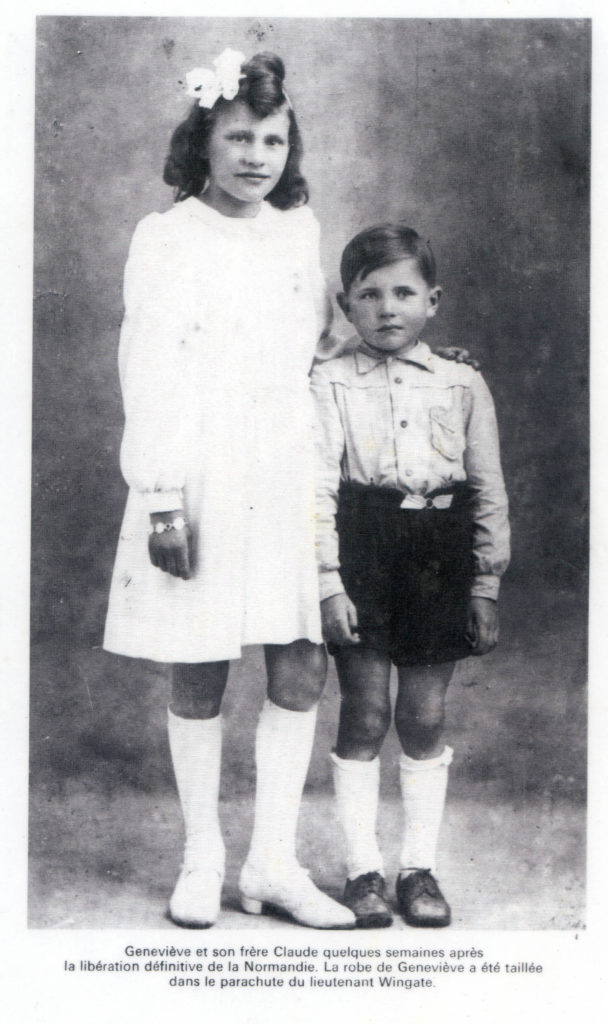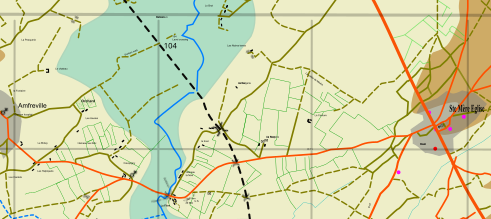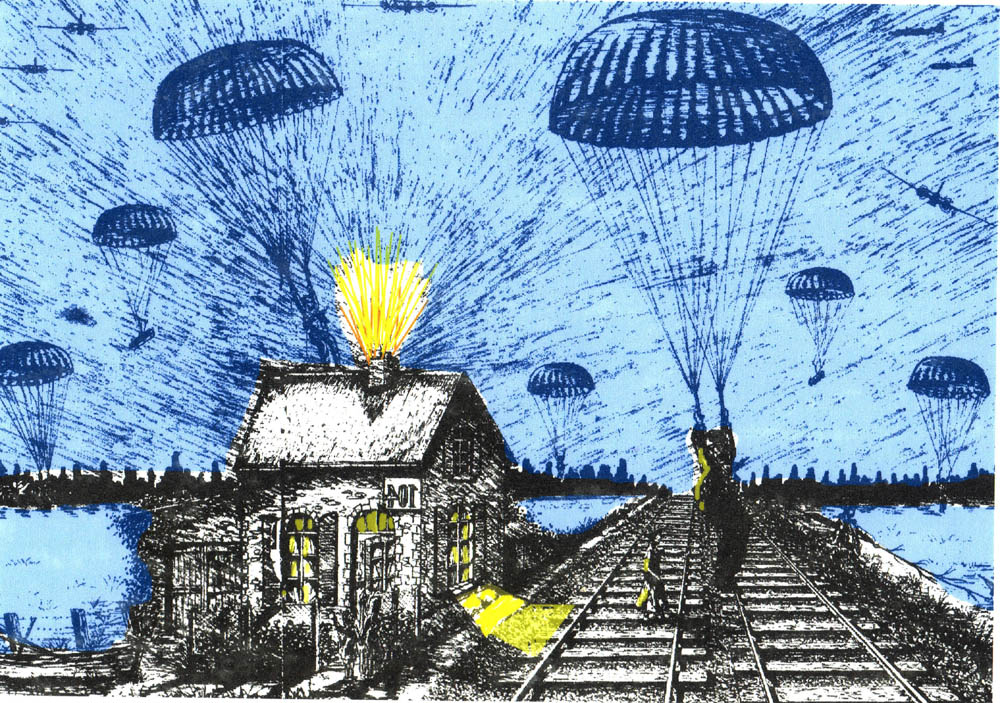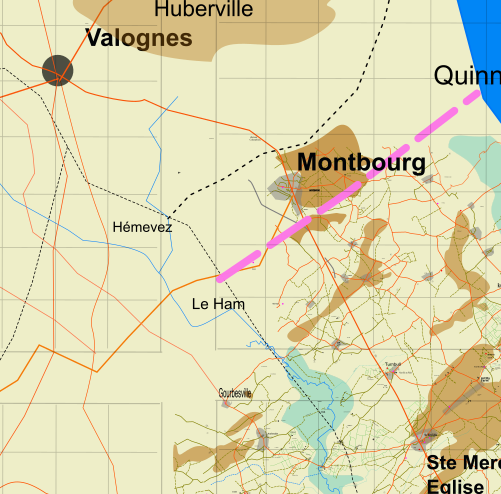Genevieve Dubosq was twelve when D-day happended. The family of 4 lived in the level crossing house 104 on the railway just a few miles North of Ste Mere eglise. Her father tended to drink too much and,she would often take the btunt og his temper.

Her father surprised her, when in 1943, some German officers came to survey the ground around their level crossing to see if it was suitable to build an airfield on. Whilst being apparently very helpful to the Germans by loading up their earth samples, he made frequent diversions through the kitchen to add spoonfuls of water.
No air field was built so they must have decided that the ground was too waterlogged. But when Rommel took over command of the “Atlantic wall” he decided to flood this Merderet River valley near St mere Eglise. The only way from their level crossing house to St
Mere Eglise was along the railway line, above flood level, to the road that runs westwards from St Mere Eglise to La fiere

The four years of occupation passed with her father being his usual violent, drunken self.
Then the night of the 5th of June arrived. There had been talk of an impending allied invasion for weeks. There were often bombing raids over the coastal fortifications, but this night the activity was more intense. Then the sky was filled with the sound of aircraft then the sight of parachutes.
Her mother realised that many of the troops would fall in the floods and be drowned. “Light a fire in the hearth” She ordered her daughter. “Load it up with wood till the soot catches fire.”
The fire was soon blazing and when the soot caught alight a giant flame spurted from the chimney. This gave a light and a signal to the paratroopers to rally to.

The house was soon full of paratroopers. Mere Duboscq plying them with soop. Pére Duboscq had already set out in his rowing boat looking for men fallen into the water or on stranded islands in the floods. He came back at regular intervals, his boat close to capsizing with the overload of men in it. He continued non stop the whole of the next day till he could find no more survivors.
As day broke the officer (might be Lt Col Linquist) rallied the men and they moved off to their objective. Several men were wounded but the officer only allowed two to stay in the house as they couldn’t possibly walk.
MR DUBOSCQ RETREIVES SUPPLIES FROM THE FLOODS
Mrs Duboscq persuaded her husband to take some rest and sustenance. Then he set out again to pick up cases of ammunition and supplies. There was soon a great pile of metal chests in the yard of the hous
A few days later two men were seen hobbling along the rail way track. They were German soldiers and were unarmed and wounded. Mere Duboscq took them in. She now had two American wounded and two German wounded. A day or two later another solitary German soldier happened by. Of the first two Germans, one was very grateful to be sheltered and looked after, the other was grumpy and brooding. The newcomer had a long discussion in German with the grumpy German. he suddenly bolted for the door and escaped. The American lieutenant on the first floor tried to get him in his sights but missed him. A short time later a German plane flew over to bomb the house. The first salve missed and the plane turned to make another sweep. This and the next also missed. the plane obviously had no more bombs and flew away. Genevieve went out side. The house was surrounded by bomb craters but none had made a direct hit.
When the situation in the surrounding area became stable the Americans and the Germans were taken to a field hospital.
The first communion ceremony in St Mere Eglise had been postponed due to the D day operations. When the allies had a firm hold of the region the ceremony could take place. Genevieve took her first communion wearing a dress made from their American lieutenants parachute.
July 25 was the breakout from the “Bocage” country.
7 august the Germans counter attacked near Avranches.
18 to 21 august was the closing of the Falaise pocket. 100 thousand Germans were surrounded. 50 000 managed to escape. 50 000 were captured or wounded.
GENEVIEVE HAS A CRUSH ON A SOLDIER
There were still American soldiers around St mere Eglise. Genevieve became friendly with a young soldier called Robert. When he learnt of the life her father caused her to live he suggested he should adopt her. Supprisingly enough her father was in agreement. But, Genevieve wanted more than that from her soldier. She wanted to become his wife. They agreed that he would adopt her as soon as it was possible and <hen she was 16 they could marry.
Robert had to move soon after. He would be back as soon as he had some leave.
Genevieve spent much time, with her young brother, at the bridge where the camp had been. One day he was playing some distance from her when he tripped on a wire. he called to Genevieve to free his foot. She pulled on the wire and triggered the mine that was buried there. Her brother was killed instantly and she was nearer dead than alive.
Weeks later she came out of her coma. The doctors and her family told her her brother was being cared for in another ward. Against all odds she made gradual progress back to recovery. her mother visited her frequently. Making the 1 5 mile one way trip to Valognes by foot. her father didn’t come.

One day when she was making great progress, her father erupted into the ward.
“I can’t stand the lies any more. Your brother’s dead and it’s your fault. You’ll never see your soldier again. I’ve forbidden him to come”
This was a great blow to Genevieve which had a great effect on her physical state. But she finally recovered after many operations.
In 1977, Philip Jutras, the curator of the St Mere Eglise museum, bestowed a medal on Genevieve and her father for their valiant efforts in helping the GIs on the night of the 5th June and the weeks that followed.
The whole story can be read in the book by Genevieve Duboscq “My longest night”
In 1965 Genevieve made a pilgrimage to Jerusalem on foot with a donkey. She wrote an account of her journey called “And God saved my Son”